
With support and feedback from the National Center for Learning Disabilities (NCLD), we recently launched a three-part “Problem of Practice” series focused on supporting diverse learners utilizing specific strategies from the Blended and Personalized Learning At Work site as well as research and insights obtained from the team at NCLD. Being strategic about how we support our diverse learners within innovative models is key to ensuring an equitable education for all students. NCLD addresses this by posing a critical question in their recent EdWeek article, Student-Centered Learning and Inclusion: Getting the Details Right, stating “intentionality is a key factor in successful implementation of student-centered approaches,” and we as “practitioners, leaders, and policymakers” need to “ask [ourselves]: are we going to leave equity and inclusion to chance or will we explicitly build protections, supports, celebrations, and access into the day-to-day and long term work?”
Diverse learners often stand to benefit the most from personalized practices that promote student ownership and agency (if done right), but also stand to suffer the most when only given limited opportunities to make learning choices and engage in meaningful peer collaboration and social interactions.
At TLA, we too believe that in order for personalized and blended learning to be successful for diverse learners, we need to be intentional and strategic around designing instruction. We must ensure rigor around not only content but social and emotional skills, as well as educator training and allocation to best support ALL learners. To address these specific challenges, the three new Problems of Practice were designed as a way for educators to explore not only the “why” but also the “how” of implementing best practices for diverse learners in a concrete and tangible manner.
- Connecting IEPs to Learner Plans
- Team Teaching & the Multi-age Classroom Approach
- Integrating UDL: Whole-Class Inclusion
- Content Expectations
- Social and Emotional/Non-cognitive Skills
Problem of Practice 3: How can strategic staffing better serve diverse learners?
- Reinventing the Special Education Teacher Role
- Training General Education Teachers and Leaders
- Lowering the Teacher-Student Ratio Through Creative Hiring
Each Problem of Practice is grounded in research, such as NCLD’s Agents of Their Own Success: Self-Advocacy Skills and Self-Determination for Students with Disabilities in the Era of Personalized Learning. These resources shouldn’t be seen as explicit user guides, but instead explorative tools for educators and leaders alike to re-examine their models and approaches to ensure that the needs of their diverse learners are not only being met but thoroughly supported.
NCLD shared, “The ironic and unfortunate fact (about this outcome) is that these students with disabilities – the students who stand to benefit most from being included in personalized learning and exercising agency – are the very students who are often denied the opportunity to participate.” We hope that by building out concrete resources and framing structures, educators are able to reflect and iterate on their current practices to ensure this is not the case.
Feel free to email me at juliana.finegan@learningaccelerator.org with any thoughts, reflections, and/or additional resources.

